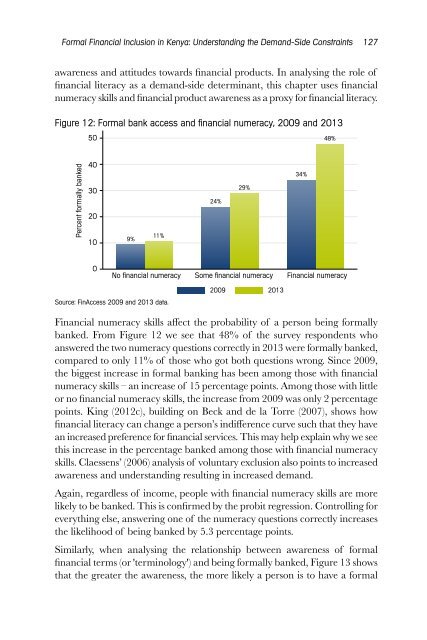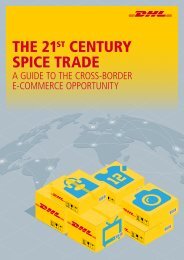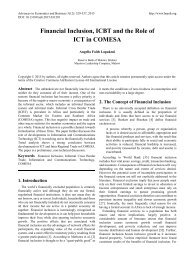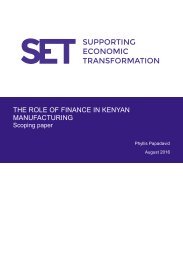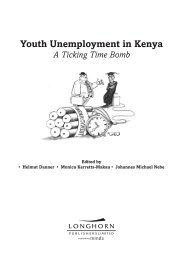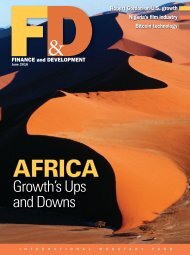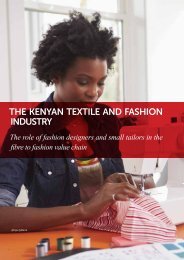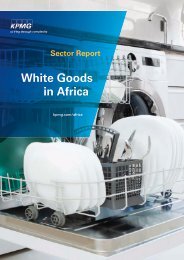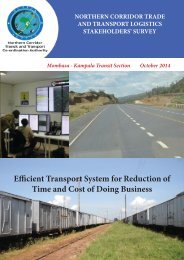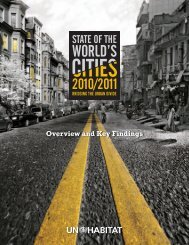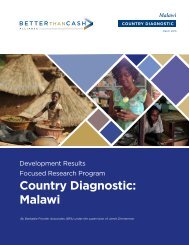in the 21st Century
hTOE305aYVW
hTOE305aYVW
You also want an ePaper? Increase the reach of your titles
YUMPU automatically turns print PDFs into web optimized ePapers that Google loves.
Formal F<strong>in</strong>ancial Inclusion <strong>in</strong> Kenya: Understand<strong>in</strong>g <strong>the</strong> Demand-Side Constra<strong>in</strong>ts 127<br />
awareness and attitudes towards f<strong>in</strong>ancial products. In analys<strong>in</strong>g <strong>the</strong> role of<br />
f<strong>in</strong>ancial literacy as a demand-side determ<strong>in</strong>ant, this chapter uses f<strong>in</strong>ancial<br />
numeracy skills and f<strong>in</strong>ancial product awareness as a proxy for f<strong>in</strong>ancial literacy.<br />
Figure 12: Formal bank access and f<strong>in</strong>ancial numeracy, 2009 and 2013<br />
50<br />
48%<br />
Percent formally banked<br />
40<br />
30<br />
20<br />
10<br />
9%<br />
11%<br />
24%<br />
29%<br />
34%<br />
0<br />
No f<strong>in</strong>ancial numeracy Some f<strong>in</strong>ancial numeracy F<strong>in</strong>ancial numeracy<br />
Source: F<strong>in</strong>Access 2009 and 2013 data.<br />
2009 2013<br />
F<strong>in</strong>ancial numeracy skills affect <strong>the</strong> probability of a person be<strong>in</strong>g formally<br />
banked. From Figure 12 we see that 48% of <strong>the</strong> survey respondents who<br />
answered <strong>the</strong> two numeracy questions correctly <strong>in</strong> 2013 were formally banked,<br />
compared to only 11% of those who got both questions wrong. S<strong>in</strong>ce 2009,<br />
<strong>the</strong> biggest <strong>in</strong>crease <strong>in</strong> formal bank<strong>in</strong>g has been among those with f<strong>in</strong>ancial<br />
numeracy skills – an <strong>in</strong>crease of 15 percentage po<strong>in</strong>ts. Among those with little<br />
or no f<strong>in</strong>ancial numeracy skills, <strong>the</strong> <strong>in</strong>crease from 2009 was only 2 percentage<br />
po<strong>in</strong>ts. K<strong>in</strong>g (2012c), build<strong>in</strong>g on Beck and de la Torre (2007), shows how<br />
f<strong>in</strong>ancial literacy can change a person’s <strong>in</strong>difference curve such that <strong>the</strong>y have<br />
an <strong>in</strong>creased preference for f<strong>in</strong>ancial services. This may help expla<strong>in</strong> why we see<br />
this <strong>in</strong>crease <strong>in</strong> <strong>the</strong> percentage banked among those with f<strong>in</strong>ancial numeracy<br />
skills. Claessens’ (2006) analysis of voluntary exclusion also po<strong>in</strong>ts to <strong>in</strong>creased<br />
awareness and understand<strong>in</strong>g result<strong>in</strong>g <strong>in</strong> <strong>in</strong>creased demand.<br />
Aga<strong>in</strong>, regardless of <strong>in</strong>come, people with f<strong>in</strong>ancial numeracy skills are more<br />
likely to be banked. This is confirmed by <strong>the</strong> probit regression. Controll<strong>in</strong>g for<br />
everyth<strong>in</strong>g else, answer<strong>in</strong>g one of <strong>the</strong> numeracy questions correctly <strong>in</strong>creases<br />
<strong>the</strong> likelihood of be<strong>in</strong>g banked by 5.3 percentage po<strong>in</strong>ts.<br />
Similarly, when analys<strong>in</strong>g <strong>the</strong> relationship between awareness of formal<br />
f<strong>in</strong>ancial terms (or 'term<strong>in</strong>ology') and be<strong>in</strong>g formally banked, Figure 13 shows<br />
that <strong>the</strong> greater <strong>the</strong> awareness, <strong>the</strong> more likely a person is to have a formal


